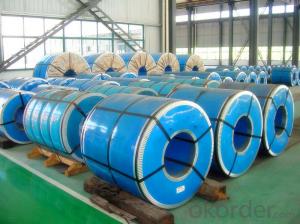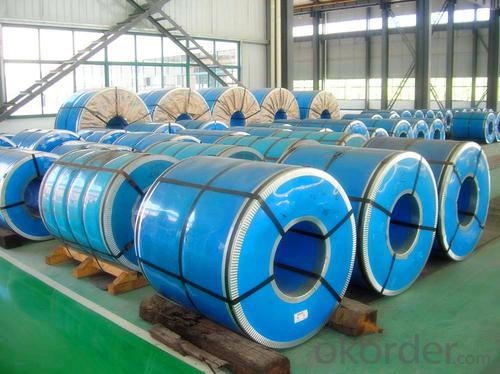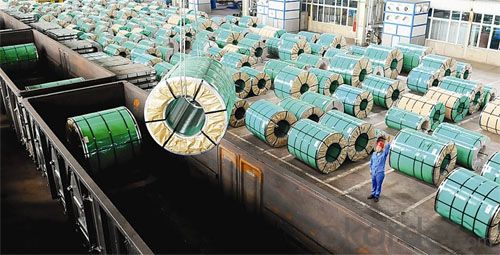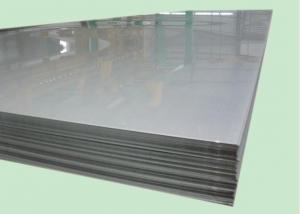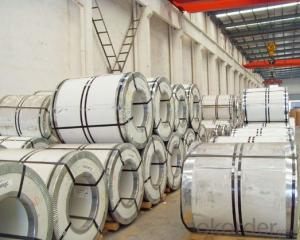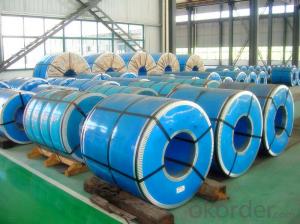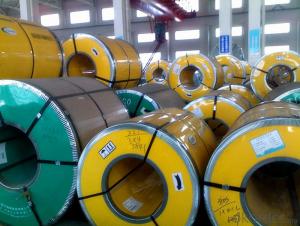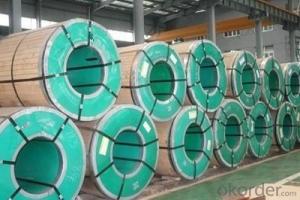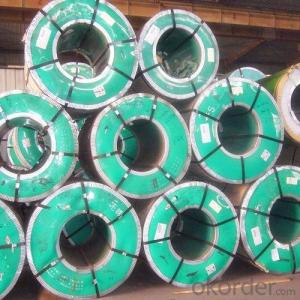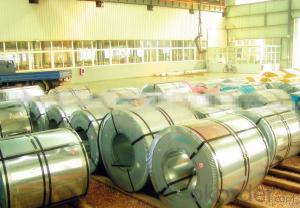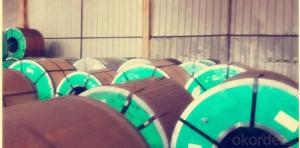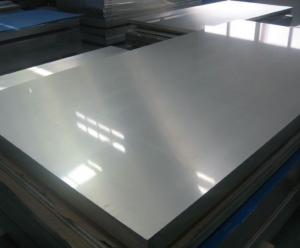Hot Rolled Stainless Steel Coil 304 Wide Strip No.1 Finish
OKorder Service Pledge
OKorder Financial Service
You Might Also Like
Type | Hot Rolled Stainless Steel Coil 304 Wide Strip No.1 Finish |
Thickness | 2.5mm-4.0mm |
Width | 1000mm, 1219mm, 1240mm, 1500mm |
Length | according to weight |
Brand name | CNBM |
Standard | ASTM, AISI, DIN, GB, JIS etc |
Material | 304 |
Application | Foodstuff, Gas, metallurgy, biology, electron, chemical, petroleum, boiler, nuclear energy, Medical equipment, fertilizer etc |
Package | Standard export sea-worthy packing |
Delivery time | Within 15 days since getting the deposit or LC origin |
Surface | No.1 |
Productivity | 20000 tons/month |
Hot Rolled Stainless Steel Coil 304 Wide Strip No.1 Finish Chemical Composition:
(%):C=0.07, Mn=2.00, P=0.045, S=0.030, Si=0.075, Cr=17.5-19.5, Ni=8.0-10.5, N=0.10
Hot Rolled Stainless Steel Coil 304 Wide Strip No.1 Finish Physical Properties
Tensile strength σb (MPa) ≥ 520
The conditions yield strength σ0.2 (MPa) ≥ 205,
Elongation δ5 (%) ≥ 40
Reduction of ψ (%) ≥ 50,
Hardness: ≤ 187
HB; ≤ 90
HRB; ≤ 200H
- Q: Can stainless steel strips be used in the production of cutlery?
- Yes, stainless steel strips can be used in the production of cutlery. Stainless steel is a popular choice for cutlery due to its durability, resistance to corrosion, and easy maintenance. Stainless steel strips can be shaped and formed into the desired cutlery shapes, providing a sturdy and long-lasting product.
- Q: Can stainless steel strips be used in solar panels?
- Solar panels can indeed utilize stainless steel strips. Due to its durability and resistance to corrosion, stainless steel is an excellent choice for a range of uses, including solar panels. It offers structural support and helps uphold the overall integrity of the solar panel assembly. In solar panel installations, stainless steel strips are frequently employed for framing and mounting purposes. They provide exceptional strength and stability, ensuring the panels remain firmly in position, even when faced with severe weather conditions. Furthermore, stainless steel's ability to resist corrosion makes it an ideal material for outdoor applications, as it can endure exposure to UV radiation, moisture, and other environmental elements commonly encountered in solar panel systems.
- Q: Can stainless steel strips be used in marine environments?
- Yes, stainless steel strips can be used in marine environments. Stainless steel is known for its corrosion resistance properties, making it suitable for various marine applications such as shipbuilding, offshore structures, and marine equipment. The chromium content in stainless steel forms a protective passive layer on the surface, preventing corrosion caused by saltwater and other harsh environmental conditions typically found in marine environments.
- Q: How do stainless steel strips perform in high-pressure environments?
- Stainless steel strips are known for their exceptional performance in high-pressure environments. These strips are commonly used in industries such as oil and gas, chemical processing, and power generation, where they are exposed to extreme pressures and temperatures. One of the key advantages of stainless steel strips is their high strength and resistance to deformation. They can withstand the intense pressure exerted on them without distorting or losing their structural integrity. This makes them ideal for applications where there is a need for reliable and durable materials. Moreover, stainless steel strips have excellent corrosion resistance properties, especially when alloyed with elements such as chromium and nickel. This protects them from the harmful effects of high-pressure environments, which often involve exposure to corrosive substances, such as acids or salts. The resistance to corrosion ensures that the strips can maintain their performance and structural strength over time. Another important feature of stainless steel strips is their ability to withstand high temperatures. They have a high melting point and can handle extreme heat without deforming or weakening. This makes them suitable for applications where high temperatures are involved, such as in heat exchangers or boilers. Furthermore, stainless steel strips offer excellent fatigue resistance, which means they can withstand repeated cycles of pressure fluctuations without cracking or failing. This is crucial in high-pressure environments where the material is subjected to constant stress and strain. Overall, stainless steel strips are highly reliable and perform exceptionally well in high-pressure environments. Their strength, corrosion resistance, heat resistance, and fatigue resistance make them a preferred choice for various industries where reliability and performance are critical.
- Q: Can stainless steel strips be used in architectural signage?
- Yes, stainless steel strips can be used in architectural signage. Stainless steel is a versatile and durable material that can withstand various weather conditions, making it suitable for outdoor signage. It also offers a sleek and modern aesthetic, making it a popular choice for architectural projects.
- Q: What is the cost of stainless steel strips?
- The price of stainless steel strips may differ based on various factors including the stainless steel grade, strip thickness and width, and the quantity being purchased. Furthermore, market conditions and the pricing strategy adopted by the supplier can also impact the cost. Typically, the price range for stainless steel strips varies from a few dollars per pound to several hundred dollars per pound. To obtain precise pricing information, it is advisable to reach out to different suppliers and furnish them with the specific requirements.
- Q: Can stainless steel strips be used in power generation industries?
- Yes, stainless steel strips can be used in power generation industries. Stainless steel is an alloy that offers excellent corrosion resistance and durability, making it suitable for various applications in the power generation sector. In power plants, stainless steel strips can be utilized in the construction of turbines, generators, and other equipment that come into contact with high temperatures, pressure, and corrosive environments. The corrosion-resistant properties of stainless steel ensure that these components can withstand the harsh conditions and maintain their structural integrity over time. Additionally, stainless steel strips can be used in the fabrication of heat exchangers, condensers, and various piping systems within power plants. The high thermal conductivity of stainless steel allows for efficient heat transfer, making it an ideal material for these applications. Moreover, stainless steel's resistance to oxidation and scaling at high temperatures makes it suitable for use in boilers and steam generators, which are crucial components of power generation systems. Overall, stainless steel strips offer numerous benefits such as corrosion resistance, durability, and high-temperature performance, making them a reliable choice for power generation industries.
- Q: Can stainless steel strips be used in automotive industries?
- Stainless steel strips have the ability to be utilized within the automotive sector. The properties of stainless steel, including its impressive resistance to corrosion, high strength, and durability, establish it as an appropriate material for a variety of applications in the automotive industry. Automotive components, such as exhaust systems, trim, body panels, brackets, and reinforcements, are frequently manufactured using stainless steel strips. These strips possess the capability to withstand the harsh conditions commonly found in automotive environments due to their resistance to heat, chemicals, and wear. In addition, the ease with which stainless steel strips can be shaped, welded, and fabricated allows for flexibility in design and efficient production. As a result, stainless steel strips have become a dependable and widely preferred choice in the automotive industry.
- Q: What are the common uses of stainless steel strips in the electronics industry?
- Due to their exceptional properties and versatility, stainless steel strips find various applications in the electronics industry. One of these is their use as shielding material to minimize electromagnetic interference. This interference can have a negative impact on the performance of electronic devices, which is why stainless steel strips are utilized for their excellent electromagnetic shielding properties. They effectively prevent the leakage or absorption of electromagnetic radiation, ensuring the smooth functioning of electronic components. In addition, stainless steel strips are commonly employed as connectors in the electronics industry. Due to their high electrical conductivity and corrosion resistance, they make reliable connector pins or terminals. This allows for efficient transmission of electrical signals and ensures a durable connection between different electronic components. Furthermore, stainless steel strips are utilized in the production of springs and contacts for various electronic devices. Their exceptional elasticity and resilience make them suitable for applications where electrical contacts need to be maintained under pressure. Stainless steel strips can withstand repeated bending and stretching without losing their shape or functionality. This makes them an ideal choice for use in switches, relays, and other electronic components. Moreover, stainless steel strips are also used in the manufacturing of battery contacts. These contacts require corrosion resistance and excellent electrical conductivity to ensure the proper functioning of the battery. Stainless steel strips fulfill these requirements, providing a reliable current flow and preventing any potential damage or degradation caused by corrosion. In summary, the wide range of uses for stainless steel strips in the electronics industry includes their use as shielding material, connectors, springs, contacts, and battery contacts. Their exceptional properties, such as corrosion resistance, electrical conductivity, and elasticity, make them an ideal choice for various electronic applications.
- Q: What are the physical properties of stainless steel strips?
- Stainless steel strips have several distinct physical properties that make them a popular choice in various industries. Firstly, stainless steel strips are known for their high strength and durability. This material possesses excellent tensile strength, allowing it to withstand heavy loads and resist deformation or breakage. Another important physical property of stainless steel strips is their corrosion resistance. This material is specifically designed to resist oxidation and corrosion, making it ideal for applications that involve exposure to moisture, chemicals, or harsh environments. Stainless steel strips can maintain their integrity and appearance even in corrosive conditions, minimizing the need for frequent maintenance or replacement. Stainless steel strips also exhibit a high melting point, which contributes to their overall strength and heat resistance. This property makes stainless steel strips suitable for applications that involve high temperatures, such as in the automotive, aerospace, or manufacturing industries. Additionally, stainless steel strips are known for their excellent conductivity. This material can efficiently conduct heat and electricity, making it suitable for applications that require efficient heat transfer or electrical conduction, such as in the construction of appliances, electrical enclosures, or heat exchangers. Moreover, stainless steel strips have a visually appealing appearance due to their smooth and lustrous surface. This property makes them popular in architectural and decorative applications where aesthetics are important. In summary, the physical properties of stainless steel strips include high strength, corrosion resistance, high melting point, excellent conductivity, and visually appealing appearance. These properties make stainless steel strips versatile and widely used in various industries, including construction, automotive, aerospace, and manufacturing.
Send your message to us
Hot Rolled Stainless Steel Coil 304 Wide Strip No.1 Finish
OKorder Service Pledge
OKorder Financial Service
Similar products
Hot products
Hot Searches
Related keywords
